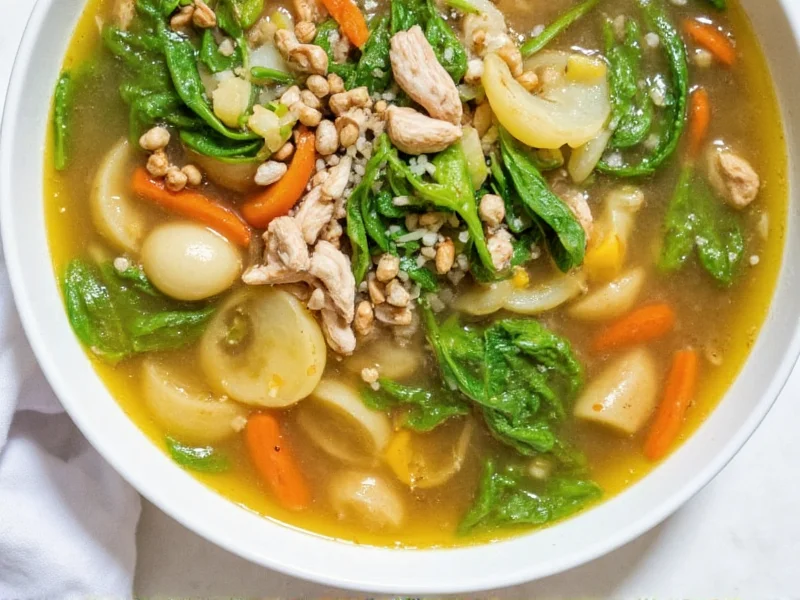Originating from Italian cucina povera ("poor kitchen") traditions, chicken escarole soup transforms humble ingredients into a deeply satisfying meal. The slight bitterness of escarole balances perfectly with savory chicken broth, creating a complex flavor profile that has made this dish a staple in Italian-American households for generations. Unlike many quick-fix recipes, authentic chicken escarole soup requires careful attention to ingredient quality and cooking technique to achieve its characteristic depth of flavor.
The Essential Components of Perfect Chicken Escarole Soup
Understanding each element's role elevates your cooking from basic to exceptional. Escarole, a member of the endive family, provides a distinctive bitter note that mellows beautifully when cooked. When selecting escarole, look for crisp, vibrant green leaves without yellowing. The chicken component typically uses bone-in pieces for superior flavor, though skilled cooks can achieve excellent results with boneless options when prepared properly.
| Ingredient | Traditional Role | Substitution Options |
|---|---|---|
| Escarole | Provides bitter counterpoint to rich broth | Radicchio (½ amount), spinach (milder flavor) |
| Chicken thighs | Creates rich, gelatinous broth | Breasts (less flavorful but leaner) |
| Garlic | Foundation of flavor | Shallots (sweeter profile) |
| White beans | Adds heartiness and protein | Ditalini pasta, farro, or none for lower carb |
Step-by-Step Preparation Guide
Mastering chicken escarole soup preparation requires understanding the sequence that maximizes flavor development. Begin by sweating aromatics—never browning them—as this creates the flavor base without bitterness. Add chicken stock gradually, allowing each addition to absorb the vegetable flavors. When using bone-in chicken, simmer gently for 25 minutes before removing to prevent stringiness.
The critical moment comes when adding escarole. Cut away the tough white base, then wash leaves thoroughly to remove trapped sand. Add the escarole in batches, allowing each addition to wilt before adding more. This technique prevents waterlogging and preserves the greens' vibrant color. For optimal texture, add the escarole during the final 5-7 minutes of cooking—any longer and it loses its distinctive character.
Avoiding Common Preparation Mistakes
Many home cooks make critical errors that compromise this soup's quality. Overcooking escarole transforms its pleasant bitterness into unpleasant harshness. Adding acidic ingredients like tomatoes too early prevents beans from softening properly. Using pre-cooked chicken often results in dry, stringy meat since it lacks the gelatinous richness from simmering bones.
For restaurant-quality results, prepare your stock the day before. This allows impurities to settle and fat to congeal for easy removal, creating a crystal-clear broth. When incorporating beans, add them during the last 15 minutes of cooking to maintain their shape and texture. Remember that escarole continues cooking from residual heat, so remove the soup from burner just before the greens reach your desired tenderness.
Nutritional Benefits and Serving Suggestions
Chicken escarole soup delivers impressive nutritional value with approximately 280 calories per serving. Escarole provides 300% of your daily vitamin K needs and significant vitamin A, while chicken offers 25 grams of lean protein. The natural bitterness of escarole stimulates digestion, making this soup an excellent starter for heavier meals.
Serve this soup in pre-warmed bowls to maintain optimal temperature. A sprinkle of freshly grated Pecorino Romano adds salty complexity without overwhelming the delicate balance. For authentic presentation, include a lemon wedge on the side—many traditional Italian cooks believe the acidity enhances the escarole's natural flavors. Pair with crusty bread for dipping, but avoid heavy sides that would compete with the soup's subtle complexity.
Storage and Reheating Techniques
Proper storage maintains quality for up to four days in airtight containers. Interestingly, the flavors deepen overnight as the escarole fully absorbs the broth's seasonings. When reheating, add a splash of water or additional broth to compensate for liquid absorption. Never microwave escarole soup directly from refrigerated temperatures—this causes uneven cooking and texture degradation.
For best results, gently warm the soup over medium-low heat, stirring occasionally until just heated through. If you've added pasta, store it separately from the broth to prevent mushiness. Freezing works well for broth-based versions, but avoid freezing with escarole as it becomes unpleasantly soft upon thawing. Instead, freeze the broth and chicken components, then add fresh escarole when reheating.
Frequently Asked Questions
Can I use kale instead of escarole in chicken soup?
Yes, but with adjustments. Kale requires longer cooking than escarole to soften its tough fibers. Add kale 10-15 minutes earlier than escarole would be added, and consider removing the thick central ribs for more tender results. The flavor profile will be earthier with less bitterness.
How do I prevent escarole from becoming bitter in soup?
Add escarole during the final 5-7 minutes of cooking. The bitter compounds break down with prolonged heat exposure. Including a small amount of acid (like lemon juice) at the end balances bitterness naturally. Avoid adding salt until after the escarole has cooked, as salt can intensify bitter notes.
What's the difference between chicken escarole soup and Italian wedding soup?
While both are Italian chicken soups, wedding soup traditionally contains meatballs and greens like spinach, while escarole soup features larger escarole pieces without meatballs. Escarole soup often includes white beans and has a more pronounced bitter note from the escarole, whereas wedding soup balances multiple flavors with its meatball component.
Can I make chicken escarole soup in a slow cooker?
Yes, but with timing adjustments. Sauté aromatics first, then cook on low for 6-7 hours with chicken and broth. Add escarole during the last 30 minutes to prevent overcooking. The slow cooker's gentle heat develops deep flavors, but you must add the greens late to maintain texture and color.
Why does my chicken escarole soup taste bland?
Blandness typically comes from insufficient layering of flavors. Proper technique involves seasoning each component: salt vegetables while sautéing, season chicken before adding, and adjust broth seasoning throughout cooking. Using homemade stock instead of store-bought broth dramatically improves depth. Remember to finish with a splash of acid (lemon or vinegar) to brighten all flavors.











 浙公网安备
33010002000092号
浙公网安备
33010002000092号 浙B2-20120091-4
浙B2-20120091-4